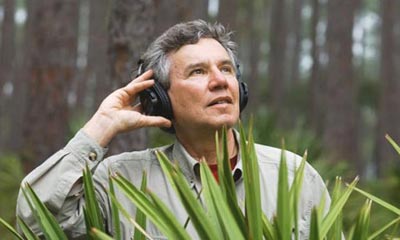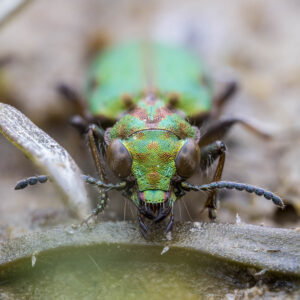Bernie Krause has a mind for sound. A pioneer in the field of bio-acoustics, Krause has made more than 4,500 recordings of over 15,000 species from marine and terrestrial habitats around the world. Half of these sounds, he estimates, have disappeared, and only exist in his sound library.
Originally a session musician for the likes of The Byrds, The Doors, and Stevie Wonder (performing as part of the Moog synthesizer duo Beaver & Krause), Bernie migrated to the world of nature sound recording in the late 1970s and has since become one of the foremost proponents of preserving soundscapes and using them as indicators of ecosystem health. He is the author of many books and articles on the subject. In the 1980s, Bernie’s sounds of humpbacks feeding were used to lure Humphrey, the celebrated “wayward whale,” back out to sea after he was spotted foundering inside San Francisco Bay.
BN: How did you come to the Bay Area?
BK: I’m a runner and I wanted a place where the air was fresh. The air was very clean here. My first wife and I moved to southern California for a few months, but we could hardly breathe there. We looked all over: Montana, the islands off Seattle, New Zealand, France… and just decided that Glen Ellen in Sonoma County was the place.
We found a rammed earth house and moved there. We decided environmentally, because of the kind of work I do, that just made sense. We haven’t developed the property very much. We still have a mountain lion and foxes on the property. We like it that way.
BN: Define “bioacoustician”.
BK: A bioacoustician studies the sounds of living organisms. In my new book, The Great Animal Orchestra: Finding the Origins of Music in the World’s Wild Places (Little, Brown and Company: 2012), I create a lexicon for sound. Most of our language about sound is dedicated to musical expressions. We don’t have words for sounds that occur outside those realms.
One of the words I play off of is “soundscapes”, which came into use in 1977 with Murray Schaeffer’s book The Tuning of the World (The Soundscape). What he didn’t discuss and define were the various sources of sound. “Geophony” is natural, non-biological noises. “Biophony” describes the sounds of wild living organisms. Third is “anthrophony” — all the sounds that humans make, primarily electromechanical sounds.
If a habitat is healthy, you see an organized relationship between the sounds. The insects have a bandwidth that is related; so do the birds; so do the mammals. The mammals usually occupy the lower frequencies, like basses at an orchestra. I describe this as the animals finding “sound niches.” If the animals are disturbed by anthrophony, they will either be stressed or die off.
It’s interesting that if you go to a place that’s healthy what you will hear in the course of a day is almost as if Darwin established the score: Insects, reptiles, amphibians, birds – all of these critters creating not only frequency bandwidth but temporal bandwidth. If one animal uses the bandwidth, another will stop, like jazz musicians trading off solos. That defines a healthy habitat.
When I got started in 1968 the model for recording sound in the field was the single species idea. You lose a lot of information this way. I started in 1968 with another premise: You better record the entire habitat. This model is now incorporated into programs in Bioacoustics at Michigan State and Purdue universities.
BN: What have you learned as you’ve listened close to home?
BK: I’ve been recording in the hills between Napa and Sonoma Valleys and we’ve found that spring is occurring earlier than it did twenty years ago, and the density and diversity of species has been changing radically.
BN: What is your training?
BK: When I began, I wanted to go into music. My major instrument was guitar. When I applied to universities and music schools in 1955, I was told that guitar didn’t count.
I got into the University of Michigan and studied history. To earn a little money, I drove into the city and played sessions with Motown bands. I made enough to support my way through school.
Then I came out here to Mills College where I studied electronic music. During that period, I met Paul Beaver, who I recorded with. The first album we did for Warner Brothers was called “In a Wild Sanctuary.” It came out seven years after Rachel Carson’s book, Silent Spring.
It required that we record natural sounds. I went to Muir Woods for the first time and I was terrified. I thought Muir Woods was as wild as it could get. That opened up my life, that soundscape with a delicate fabric of wind and leaves and ravens. It was so gorgeous. It was an epiphany.
I decided right then that’s what I wanted to do with my life. I went back to school to get a PhD in Bioacoustics. The archive that I’ve collected is one of the largest that exists. Fifty percent of it is from habitats that no longer exist, such as the forests of Zimbabwe, which have since been cut down for firewood.
BN: What is your favorite outdoor destination in the Bay Area?
BK: Sugarloaf State Park in Sonoma. I like it because it’s quiet in the morning, it’s wonderfully rich with sound, it’s a great habitat to record in and it’s still vital.
» To learn more about Krause, his library of sounds, and his work, visit his website at WildSanctuary.com. The April-June 2013 issue of Bay Nature will feature an article on nature sounds and bioacoustics, including a visit with Krause. Subscribe today to get this issue.





